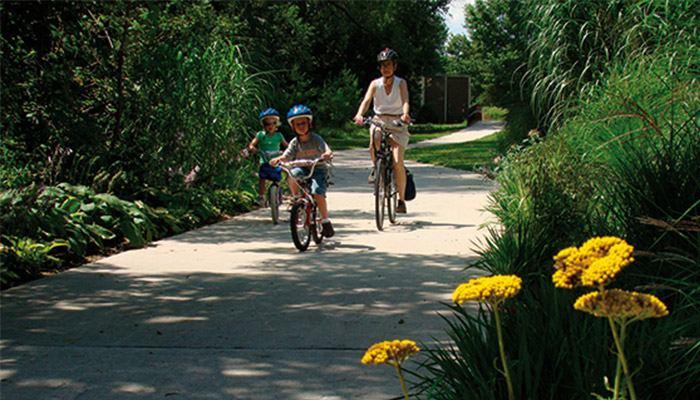
Trails are an important part of any thriving, growing community. Having a plan in place for where and when you’re going to build your trail will help you budget for it, win state and federal grants to help pay for it, and generate excitement for the project within your community.
- Planning helps to preserve the right of way for trails as development occurs. If a city doesn’t have a trails plan in place, it will likely come as an afterthought as development occurs. Any room left over for a trail will likely be in a less desirable location, cost more, and not offer as good of access for the surrounding community and larger trail system.
- Planning shows commitment (and is usually a requirement) when applying for funding assistance. There are state and federal grant programs available to fund trail construction, but the factors that are considered during the application scoring process include whether a city has a plan in place, if adjacent property owners are aware and in favor of the project, and has the City already budgeted funding for construction and maintenance of the trail. For example, the federal Surface Transportation Block Grant (STBG) requires a discussion on how the project impacts other city/county goals, plans and projects. It is not enough to simply say that a City has a Complete Streets Policy in place. A trails plan and inclusion in the city’s capital improvement plan (CIP) goes beyond this by adding a vision and traction for the policy, showing the project is a priority and meets their goals/plans.
- A trails plan can be used for economic development within a community. Studies have shown that trails provide many amenities for a community. They increase property values and add to overall neighborhood safety. They encourage healthy, active lifestyles. This makes communities with trails more attractive to prospective employers, because they know that they will be able to attract a higher level of employees.
- Planning helps break trail projects up into manageable segments. It is nearly impossible to fast track a good trail system. Funding and budgeting, land acquisition and construction all take time. A good trail plan is a living document that helps to focus long-term efforts. It is also very useful to leverage the city’s funds with roadway projects when an opportunity presents itself. Knowing the estimated costs and needs for various trail segments (i.e. will a bridge be needed?) can help cities prioritize construction projects and budget how far they can reasonably build at a time. The easier or higher priority segments can be completed first, and as residents begin using them, this generates support and excitement for the trail.
- A trails plan can be used for public education. When residents approach the city with questions or concerns, a trails plan can show them why certain segments were built first and what future projects are planned. When people can see the overall big picture, it makes it easier to understand how the smaller pieces align with the long-term goals.
Sometimes trails can be paid for exclusively through grants. Sometimes grants will require matching funds from the city. Some communities dedicate their local-option sales tax (LOST) funds to parks and trails. These are all decisions that can be made while developing your trails plan.
One community I worked with wanted to create a plan for designating trails within the existing town limits as well as connecting future neighborhoods up to two miles outside of the city limits. This included a connection to a regional rail trail that went through the town. I started by asking questions:
- Where do you want to connect to? Does the City have priority development areas, parks, destinations, etc.?
- What street and sidewalk networks already exist?
- Which routes would be the best way to connect based on surrounding drainage ways and development?
- Which streets are conducive to bike lanes or widened sidewalks (aka sidepaths)?
Once we had the answers to these questions, we were able to help the city break down the plan into segments with cost estimates for each. Then we prioritized the segments, starting with the ones that would generate the most excitement and have the most benefit early on.
The city had an ordinance that all curbed roadways required a sidewalk. As development occurred along a curbed roadway, the sidewalks and/or sidepaths would be constructed by the developer. However, there was a rural roadway leading into town where neighborhoods were springing up. Due to the location, it could be years before curbs were added to the roadway, but because it was part of their trails plan to connect these neighborhoods to town and the regional rail trail, they were able to require developers to include a 10-foot sidepath along the roadway where indicated in the plan. As this stretch of roadway fills in with more developments, there will now be a continuous trail available to the residents of these neighborhoods that will connect them to the town’s trail network.
